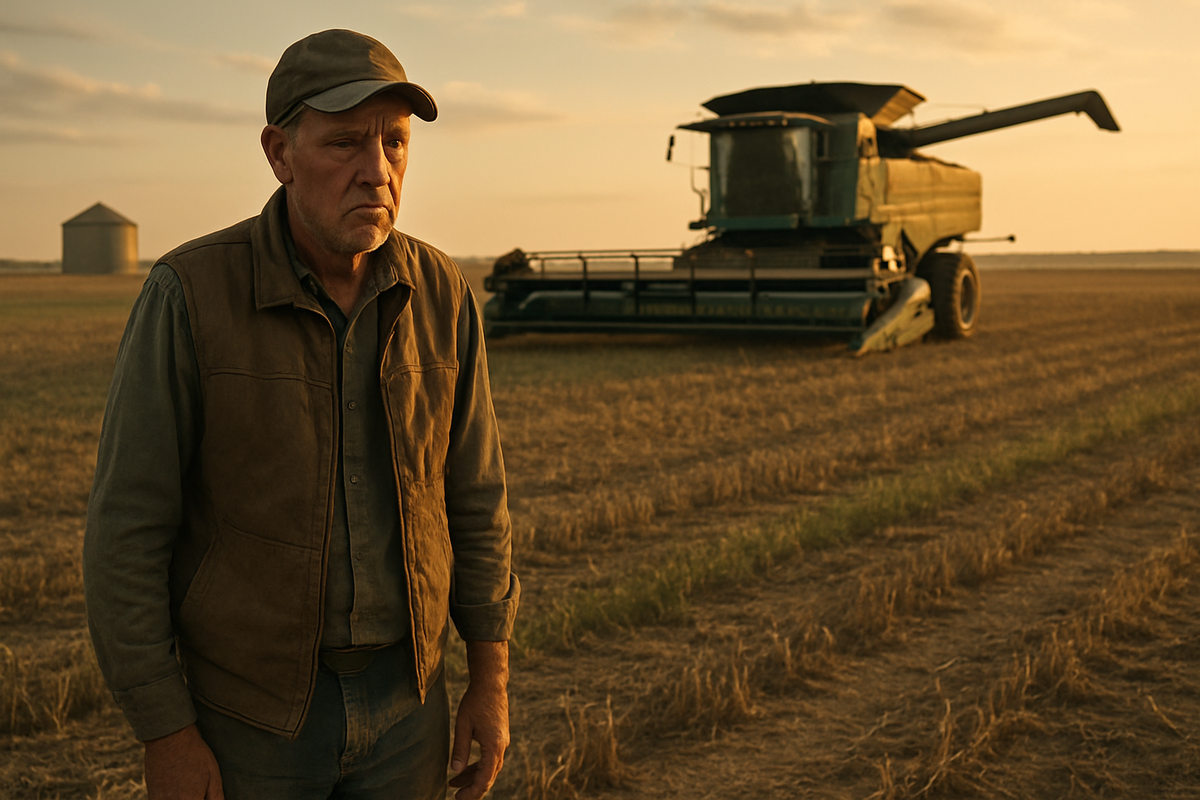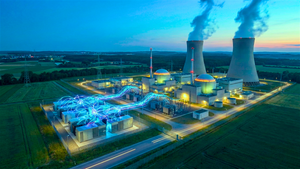
October 14, 2025 – A perfect storm is brewing in America's heartland, threatening the financial stability of farmers nationwide. As of October 2025, agricultural producers are facing an unprecedented squeeze: persistently low commodity prices for staple crops like corn and soybeans, coupled with relentless increases in the cost of essential inputs such as labor, fertilizer, and fuel. This "paradox of plenty," where abundant harvests paradoxically depress prices, is pushing many operations into the red, raising concerns about the long-term viability of the agricultural sector and its ripple effects across the economy.
The immediate implications are stark. Farmers, particularly those in row crop production, are struggling to break even, with significant per-acre losses reported for cotton, peanuts, corn, and soybeans. This financial stress is leading to increased farm losses and a concerning uptick in bankruptcy filings. While net farm income is projected to rise in 2025, this growth is largely a mirage, driven by a substantial surge in federal disaster aid and direct government payments, rather than improved market conditions. The reliance on government lifelines underscores the severity of the market imbalance and the urgent need for sustainable solutions to ensure the resilience of U.S. agriculture.
The Unfolding Crisis: A Deep Dive into Agricultural Hardship
The current crisis facing farmers is a culmination of several intertwined factors, creating a challenging economic environment that has been steadily worsening throughout 2025. The core issue lies in a significant disconnect between the prices farmers receive for their products and the costs associated with bringing those products to market.
Agricultural commodity prices have been on a consistent downward trajectory. The World Bank's agricultural price index has declined nearly 7% since the beginning of 2025, with a forecasted overall 4% decrease for the year. Major crops have been hit particularly hard. Corn, which commanded over $7 per bushel in 2022, is now hovering around $4, representing a staggering 54% decrease. Soybeans have fallen below $10 per bushel, a 58% drop from three years prior. Wheat prices have also plummeted by 51% from their pandemic peaks, hitting a five-year low of under $5 per bushel due to large harvests and weak international demand. Cotton prices have similarly decreased by 42%. Even dairy and many fruit and vegetable prices have seen declines at the farm level. The only significant exceptions have been cattle and meat, which have seen price increases due to tight supplies, and eggs.
Concurrently, production expenses are projected to reach a record $467 billion in 2025, an increase of nearly $12 billion (2.6%) from 2024, and substantially higher than previous averages. Labor costs, now the second-largest expense, have risen by almost 50% since 2020. While fertilizer prices have retreated from their 2022 highs, they remain elevated and are expected to increase by over 7% in 2025. Seed expenses are up 18% since 2020, and crop protection costs are also climbing. Fuel and energy expenses have increased by 32% since 2020, while machinery and repair costs are soaring due to inflation in parts and services, forcing farmers to repair older equipment rather than invest in new. Perhaps most critically, interest expenses have dramatically increased by 73% since 2020, adding immense pressure as farmers rely heavily on operating loans.
Key players and stakeholders involved in this unfolding drama include individual farmers and farming cooperatives, who are on the front lines bearing the brunt of these economic pressures. Agricultural input suppliers (e.g., fertilizer, seed, machinery companies), commodity traders, and food processors are also deeply intertwined. Government bodies, such as the U.S. Department of Agriculture (USDA) and legislative bodies, play a crucial role in shaping policy and providing safety nets. Initial market reactions have been characterized by increased volatility, particularly as a recent U.S. government shutdown as of October 1, 2025, suspended the release of critical USDA reports, creating an information vacuum that destabilizes markets and forces reliance on limited private data. This uncertainty is exacerbated by shifting global trade dynamics, with major importers like China diversifying away from U.S. agricultural products, leading to projections of an 8% to 15% drop in U.S. agricultural exports in 2025.
The timeline leading to this moment has seen a gradual escalation of cost pressures post-pandemic, initially masked by strong commodity prices that have since evaporated. The high inflation environment of 2022-2024 significantly drove up input costs, while global supply chain disruptions and geopolitical events (such as the conflict in Eastern Europe impacting fertilizer supplies) further exacerbated the situation. Now, in late 2025, with bumper harvests contributing to oversupply and global demand remaining subdued for many key commodities, the structural imbalances are fully exposed, leaving farmers in a precarious position.
Companies Navigating the Agricultural Headwinds
The current agricultural downturn, marked by low commodity prices and high production costs, creates a complex landscape for publicly traded companies within and adjacent to the sector. There will be clear winners and losers, with their fortunes tied to their specific roles in the supply chain and their ability to adapt.
Potential Losers:
Companies heavily reliant on farmers' purchasing power for new equipment or high-margin inputs are likely to face significant headwinds. Deere & Company (NYSE: DE), a leading manufacturer of agricultural machinery, could see reduced demand for new tractors, combines, and other expensive equipment as farmers delay capital expenditures. While maintenance and parts sales might see a temporary uptick as farmers repair older machines, the overall trend of delayed upgrades will negatively impact their top line. Similarly, major fertilizer producers such as Nutrien Ltd. (TSX: NTR, NYSE: NTR) and Mosaic Company (NYSE: MOS) might experience pressure on sales volumes and pricing power, despite fertilizer costs remaining elevated for farmers. If farmers scale back applications to cut costs, or if global supply stabilizes, these companies could face reduced profitability. Seed and crop protection companies like Corteva, Inc. (NYSE: CTVA) and Bayer AG (ETR: BAYN), though their products are essential, could see farmers opt for cheaper generic alternatives or reduce overall acreage, impacting their market share and revenue growth, especially if their premium seed varieties become less affordable.
Potential Winners (or those more resilient):
Companies that provide essential, non-discretionary inputs or services that help farmers optimize costs or manage risk may fare better. Livestock producers and processors, such as Tyson Foods, Inc. (NYSE: TSN) or JBS S.A. (BVMF: JBSS3), could see some benefit from higher cattle and meat prices, though they also face their own input cost challenges. Companies focused on agricultural technology (AgTech) that offer solutions for precision farming, data analytics, and efficiency improvements, such as Trimble Inc. (NASDAQ: TRMB), might find a receptive market as farmers desperately seek ways to cut costs and maximize yields from existing resources. Furthermore, companies involved in food processing and distribution further up the supply chain, like Archer-Daniels-Midland Company (NYSE: ADM) or Bunge Global SA (NYSE: BG), might benefit from lower raw commodity prices at the farm gate, which can improve their margins, provided consumer demand remains stable and they can pass on their own rising processing costs. However, these gains could be tempered by global trade shifts and logistical challenges.
Overall, the agricultural sector's current struggles underscore the interconnectedness of the market. Companies with diversified revenue streams, strong balance sheets, and a focus on cost-efficiency solutions for farmers are better positioned to weather this storm, while those heavily exposed to discretionary farm spending or volatile commodity input prices face a more challenging outlook.
Broader Implications and Historical Parallels
The current agricultural crisis extends far beyond the farm gate, signaling broader industry trends and potential ripple effects across the economy. This period of low commodity prices amidst rising costs is not entirely new, but its specific drivers and global context present unique challenges.
Firstly, this event fits into a broader trend of increasing volatility in global food systems. Geopolitical tensions, climate change impacts, and disruptions to global supply chains have made agricultural markets inherently more unstable. The current situation highlights the fragility of a system where farmers are price-takers in a global market, yet face localized and often inflexible cost structures. This imbalance is exacerbating the long-term trend of consolidation in the agricultural sector, as smaller, less capitalized farms struggle to survive, potentially leading to fewer, larger operations that could impact rural economies and food diversity.
The ripple effects on competitors and partners are significant. For example, the decline in U.S. agricultural exports, particularly soybeans, due to shifts in purchasing by major importers like China towards South American producers, affects not only American farmers but also global shipping companies, port operators, and even financial institutions involved in trade finance. Domestically, rural communities dependent on agricultural prosperity will face economic contraction, impacting local businesses, services, and employment.
Regulatory and policy implications are paramount. The substantial increase in federal disaster aid and direct government payments projected for 2025 underscores a growing reliance on state intervention to stabilize the sector. This raises questions about the sustainability and efficacy of current agricultural policies. There's likely to be increased pressure for new farm bills that address risk management, provide more robust safety nets, and potentially incentivize sustainable farming practices that can reduce reliance on costly inputs. Discussions around trade agreements will also intensify, with calls for policies that protect domestic producers from unfair competition and ensure market access.
Historically, the U.S. agricultural sector has experienced similar periods of boom and bust. The farm crisis of the 1980s, driven by high interest rates, a strong dollar, and declining commodity prices, offers a stark precedent. During that era, many farmers faced foreclosures and bankruptcies, leading to significant structural changes in the industry. While the current environment differs in terms of global interconnectedness and the specific drivers of input costs, the core challenge of negative profit margins due to a cost-price squeeze remains strikingly similar. Learning from these historical events, particularly the need for proactive government intervention and adaptive farm management strategies, is crucial. The current situation also echoes periods where technological advancements led to overproduction, depressing prices, highlighting the need for market-driven solutions alongside yield improvements.
Navigating the Future: What Comes Next for Agriculture
The path forward for the agricultural sector amidst these mounting challenges is complex, with both short-term and long-term implications that will necessitate strategic pivots and adaptations across the industry.
In the short term, the immediate focus for many farmers will be on survival. This involves stringent cost-cutting measures, optimizing existing resources, and maximizing efficiency wherever possible. Expect to see a continued delay in new equipment purchases, increased reliance on repairing older machinery, and potentially a more conservative approach to planting decisions, perhaps shifting away from the most unprofitable crops or reducing acreage. The reliance on government support, including potential new programs similar to the 2019 Market Facilitation Program if trade disputes worsen, will remain a critical lifeline. For investors, this period might see heightened volatility in agricultural commodity futures as markets react to supply adjustments, weather patterns, and policy announcements.
Looking further ahead, the long-term possibilities point towards a more resilient, albeit potentially consolidated, agricultural landscape. There will be an accelerated adoption of precision agriculture technologies, data analytics, and automation. Farmers will increasingly turn to solutions that offer real-time insights into soil health, weather patterns, and input application, allowing for more targeted and efficient use of costly resources like fertilizer and water. This shift could create market opportunities for AgTech companies specializing in these areas. Furthermore, there may be a strategic pivot towards value-added agriculture, where farmers seek to process their raw commodities into higher-margin products or engage in direct-to-consumer sales, thereby capturing a larger share of the food dollar.
Potential strategic pivots also include diversification. Farmers might explore alternative crops, niche markets, or even non-agricultural income streams to de-risk their operations. Supply chain resilience will become a paramount concern, prompting efforts to shorten supply chains, foster local food systems, and reduce dependence on volatile global markets for both inputs and sales. Regulatory bodies and policymakers will likely be pushed to develop more comprehensive risk management tools and insurance programs that better account for both price and cost volatility, moving beyond traditional yield-based insurance.
Emerging market opportunities could arise in sustainable and regenerative agriculture. As consumers become more environmentally conscious, premium markets for sustainably produced food could grow, offering a potential avenue for farmers to command better prices. Companies providing services or products for carbon sequestration, soil health improvement, or reduced chemical use might also see increased demand. However, challenges will persist, including access to capital for these transitions, the need for new skill sets, and overcoming inertia within a historically traditional industry. The potential scenarios range from a gradual recovery driven by innovation and policy adjustments to a more severe consolidation phase if economic pressures remain intense, leading to significant changes in the structure of American farming.
Wrapping Up: A Crossroads for American Agriculture
The current confluence of low commodity prices and soaring production costs has placed American agriculture at a critical crossroads. The immediate financial strain on farmers is undeniable, leading to negative profit margins, increased debt, and a concerning rise in farm losses. While government support is providing a temporary buffer, it underscores the systemic imbalances within the sector rather than reflecting a return to sustainable profitability.
Moving forward, the market will likely be characterized by continued caution and strategic adaptation. Investors should watch closely for shifts in agricultural policy, particularly any new farm legislation that could introduce more robust risk management tools or direct aid programs. The performance of agricultural input companies (fertilizer, seed, machinery) will be a key indicator, as their sales directly reflect farmers' capacity and willingness to invest. Furthermore, developments in global trade relations, especially concerning major importers like China, will significantly impact commodity prices and export volumes.
The lasting impact of this period could be a more resilient, technologically advanced, but potentially more consolidated agricultural industry. Farmers who can successfully implement cost-saving technologies, diversify their operations, or find niche markets will be better positioned for long-term success. For the broader economy, the health of the agricultural sector is fundamental, influencing food security, rural economies, and even national trade balances. The challenges faced today are a stark reminder of the complex interplay of global markets, environmental factors, and policy decisions that shape the future of our food supply. Investors should monitor commodity price trends, input cost inflation, and government support levels as crucial indicators in the coming months.
This content is intended for informational purposes only and is not financial advice






